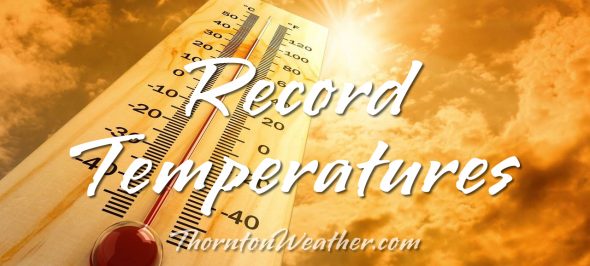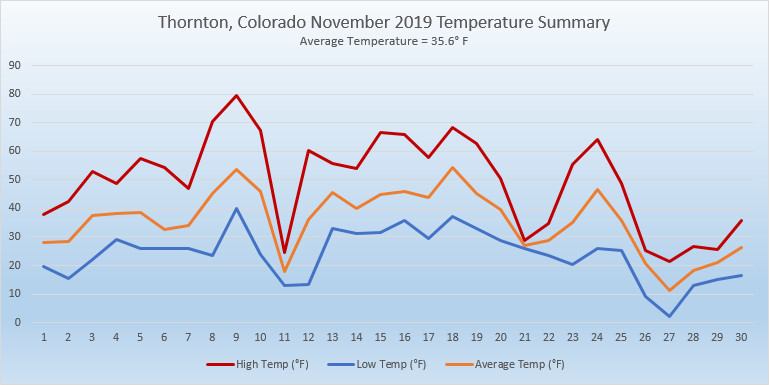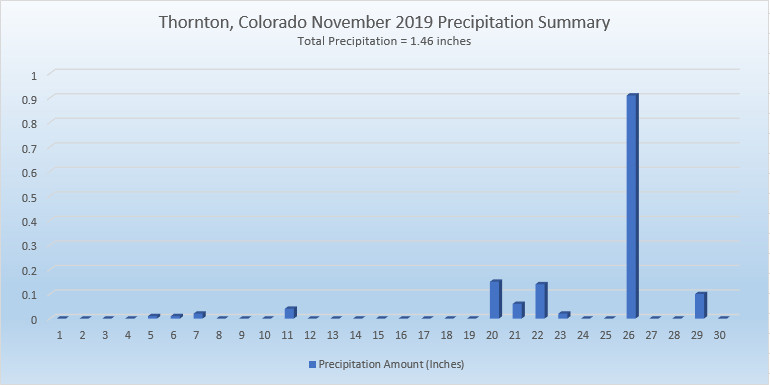As always, our look back at Denver’s weather history books is very eventful. As we start to get closer to winter, we begin to see many more multi-day snow events that are notable and this week’s look is no different. We see many major snow events and also of note are the damaging high wind events.
From the National Weather Service:
25-29
In 1985…dense fog with visibilities as low as 1/8 mile occurred on five consecutive days at Stapleton International Airport. The fog was at times accompanied by light snow… Light freezing drizzle…or ice crystals. Fog occurred all day on both the 26th and 29th.
28-29 in 1908…heavy snowfall overnight and for most of the day on the 29th totaled 12.5 inches. Precipitation was 1.09 inches. Northwest winds were sustained to 26 mph on the 29th.
In 1928…a major storm dumped 15.5 inches of snowfall on downtown Denver. North winds were sustained to 18 mph with gusts to 19 mph on the 28th.
In 1992…an upper level storm system moved across metro Denver…but left only a dusting of snow. Snowfall totaled only 1.6 inches at Stapleton International Airport where north winds gusted to 25 mph. Other snow amounts included: 8 inches at Conifer…6 inches at Lake Eldora…3 inches at Rollinsville and in southeast Denver.
In 1997…a storm system tracking across northern New Mexico produced strong north to northeast upslope flow against the eastern slopes of the Front Range and Palmer Ridge. Snowfall totals in Jefferson County included: 14 inches near Deckers; 12 inches at Castle Rock and Sedalia; 10 inches near Conifer…11 miles southwest of Morrison…and at Buffalo Creek. Elsewhere…snow accumulations were less. Snowfall totaled only 0.7 inch at the site of the former Stapleton International Airport on the 27th and 28th.
In 2004…heavy snow fell in the foothills and across metro Denver. In the foothills…snowfall totals included: 13 inches at Roxborough State Park and Eldorado Springs… 11.5 inches near Conifer…11.0 inches near Nederland…and 10 inches near Indian Hills. Across metro Denver snowfall totaled 14 inches near Sedalia…9 inches near Louisville… 8 inches at Ralston Reservoir…and 5.1 inches in the Stapleton area of Denver. Northeast winds gusted to 28 mph at Denver International Airport on the 28th.
In 2006…a slow moving storm system brought heavy snow to the mountains and to the eastern foothills where snowfall ranged from 8 to 18 inches. Some of the more impressive snow totals included: 18 inches at Genesee…17.5 inches near Boulder…17 inches at aspen springs…16.5 inches 10 miles northwest of Golden…15 inches at Eldorado Springs… 14.5 inches in Idaho Springs and near Jamestown…12 inches in grant and near Indian Hills…11.5 inches near Blackhawk… 11 inches at gross reservoir and Eldora…and 10.5 inches in Conifer. Across metro Denver…storm total snowfall generally ranged from 5 to 9 inches with the heaviest amounts near the foothills in Boulder and Jefferson counties. The most impressive totals included: 15.5 inches at Ken Caryl…12 inches in Boulder…7.5 inches near Morrison…and 7 inches near both Chatfield and Ralston reservoirs. Snowfall totaled only 4.2 inches in the Denver Stapleton area. Northeast winds gusted to 31 mph at Denver International Airport on the 28th.
28-30
In 1991…a winter storm dumped heavy snow in the foothills and near the Palmer Divide with 10 inches recorded at Conifer and Golden Gate Canyon…12 inches in Morrison… 6 inches at Castle Rock and Parker. Only 3.4 inches of snow fell at Stapleton International Airport where north winds gusting to 35 mph on the 29th…produced some blowing snow. Some light freezing drizzle also fell on the 28th and 29th.
29
In 1877…the all-time lowest recorded minimum temperature in the month of November…18 degrees below zero…occurred. The high temperature for the day was 16 degrees.
In 1899…northwest winds were sustained to 51 mph with gusts as high as 60 mph. The Chinook winds warmed the temperature to a maximum of 74 degrees…a record high for the date and the warmest of the month that year. The minimum temperature was only 39 degrees.
In 1927…post-frontal rain changed to snow and totaled 5.8 inches over downtown Denver. Northeast winds were sustained to 22 mph.
In 1977…85 mph winds were reported at Wondervu in the foothills southwest of Boulder. Northwest winds gusted to 39 mph at Stapleton International Airport.
In 1980 strong Chinook winds reached 85 mph in Boulder… Blowing traffic signals and street lights down. Some windows were shattered by the wind. West winds gusted to 37 mph at Stapleton International Airport.
In 1994…high winds blew across the Front Range eastern foothills. Wind gusts to 92 mph occurred atop squaw mountain…5 miles south of Idaho Springs…and to 82 mph on fritz peak near Rollinsville in the foothills southwest of Boulder. A wind gust to 75 mph was recorded at Jefferson County airport near Broomfield. Northwest winds gusted to only 35 mph at Stapleton International Airport. No damage was reported.
29-30
In 2008…a storm system produced locally heavy bands of snow across Douglas…Elbert and eastern Jefferson counties. Northerly winds gusting to 50 mph caused snow drifts to pile up to 2 feet in depth. Storm totals included: 12 inches just southwest of Kassler…11.5 inches…6.5 miles southwest of Castle Rock; 11 inches…8.4 miles southeast of Aurora and 9 miles west of Littleton; 10 inches at Louviers… 8 inches…2 miles west-southwest of Highlands Ranch and 5 miles south-southeast of Sedalia…and 7.5 inches…14 miles west-southwest of Agate and at Castle Pines. At Denver International Airport…2 inches of snow was observed. North winds gusted to 46 mph on the 30th.
30
In 1899…west winds were sustained to 45 mph with gusts as high as 48 mph.
In 1903…west winds sustained to 44 mph with gusts to 54 mph warmed the temperature to a high of 57 degrees.
In 1981…strong winds blasted the foothills. In Wondervu… Winds were clocked to 81 mph with many other locations in the foothills reporting over 60 mph. Northwest winds gusted to 28 mph at Stapleton International Airport.
In 1986…the worst snow storm of the season dumped from 5.0 inches of snow at Stapleton International Airport to 14 inches over the higher southwestern suburbs. On the Sunday after thanksgiving…one of the busiest travel days of the year at Stapleton International Airport…two of the four runways were closed and flights were delayed up to four hours. Near-blizzard conditions prevailed on the plains east of Denver…closing both I-70 and I-76 for a time. North wind gusts to 36 mph were recorded at Stapleton International Airport.
In 2000…strong winds raked metro Denver. In Thornton…a construction worker was critically injured when the scaffolding on which he was standing collapsed…throwing him 25 feet to the ground. West winds gusted to 54 mph at Denver International Airport.
30-1
In 1929…heavy snow blanketed the city. Snowfall totaled 9.8 inches downtown. North winds were sustained to 32 mph with gusts to 37 mph on the 30th.
In 1970…high winds blasted Boulder and the eastern plains. In Boulder…a wind gust to 112 mph was recorded at the National Center for Atmospheric Research with a gust to 96 mph at the national bureau of standards. In downtown Boulder…wind gusts reached 76 mph. At Stapleton International Airport…winds gusted to 47 mph. The high winds caused widespread light to moderate property damage across most of metro Denver. Roofs…signs…trees…power lines…and other property were damaged. Blowing dust reduced visibility to near zero over most of eastern Colorado. Several mobile homes…campers…and semi- trailers were blown off the highways north of Denver.
In 1985…an intrusion of cold arctic air into metro Denver resulted in setting 3 temperature records. The temperature climbed to only 17 degrees on the 30th…setting a record low maximum for the date. On the 1st…the temperature plunged to 6 degrees below zero…setting a record low for the date… And warmed to only 7 degrees…setting a record low maximum for the date.
30-2
In 1975…very strong Chinook winds up to 100 mph caused damage to homes…aircraft…aircraft hangars…mobile homes… Cars…and power lines along the eastern foothills. Strong northwest winds gusted to 39 mph at Stapleton International Airport on both the 30th and the 1st.
Continue reading November 29 to December 5: This week in Denver weather history


 The weather during the month of November in Denver metro area can offer just about anything. While it is normally a quiet month, it can be prone to extremes.
The weather during the month of November in Denver metro area can offer just about anything. While it is normally a quiet month, it can be prone to extremes.


